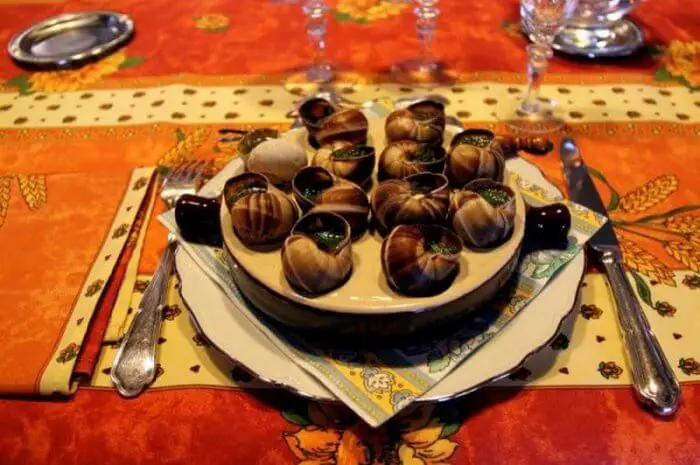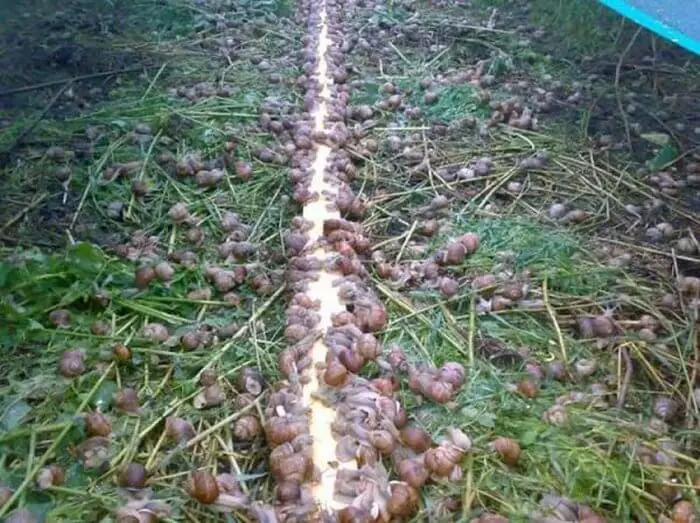Snail farming is a new direction of “animal husbandry” in Europe and one of the options for small businesses. See in this issue how this “horny treat” is grown on special farms.
It is believed that grape snails spread throughout Europe from Italy. They do not live in central Russia, but they are often found in the Baltic States, the Kaliningrad region, and on the southern outskirts of our country. They love a humid warm climate: old gardens, ravines overgrown with bushes. There they are collected by collectors, sending them in large quantities, fresh and frozen, to supermarkets and restaurants in developed European countries. The demand is great and growing constantly. In this horny and slimy delicacy, meat that is completely free of cholesterol and unhealthy fats is extremely prized. Consisting of pure healthy protein, amino acids essential for humans, and a host of different vitamins. Yes, it also increases potency.

In addition to sea mollusks, popular all over the world, in France they also love the land – grape snails (Helix pomatia). Soft-bodied delicacies are called by the pretty word “escargot” and are sold in any supermarket. Fishing (hunting? Collecting? Catching?) Of wild snails is becoming more and more difficult in France due to the destruction of the natural habitat, therefore it cannot satisfy the appetite of a gourmet nation. The food problem is partly solved through imports. But patriotic French people prefer domestic goods, they sincerely believe that everything French is the best in the world. Therefore, the only solution is to breed in captivity.
The humid sea air of Brittany is excellent for this land clam. Le Croisic is home to one of the many French snail farms. The farm is called “pedagogical”, as it regularly hosts guided excursions, who presents a view of Helix pomatia, unexpected for a zoologist. A typical phrase of the guide near the poster depicting the anatomy of the snail: “… At the end of the shell is the liver. If this organ is not removed, the taste of the snail will be spoiled. ”

Snail farms began to be organized when the areas of abandoned gardens and ravines were reduced or completely disappeared when in some European countries it was forbidden to collect grape snails, taking them under protection.
Beautiful, light brown, with dark stripes and almost completely curled carapace, large, up to almost 5 cm in length and height. Some people even keep them at home as pets, no matter how ridiculous it may sound.
The cultivation of snails begins with reproduction. Breeder snails are given a special diet rich in carrots. It is surprising for us that each individual of the snail has both male and female reproductive organs (although from the point of view of snails, probably men and women are inferior creatures …). The snails are planted in pairs and they fertilize each other. Since snails lay their eggs in the ground, after mating, the producers are planted in special small pots with soil. Then the valuable contents of the pots are placed in an incubator.
Newborn snails live in a mini-terrariums, and the grown ones are moved to an open-air cage with mesh walls, on boards that slide into special boxes, like in a writing desk. The “young” are fed with carrots with cereal grains. Farm snails reach gastronomic sizes (like plums) in a few months; “Wild” snails in nature need a year and a half for this. Here, on the farm, in a special laboratory certified by the sanitary and veterinary inspections, snails are cultivated.
First, they are placed in boiling water for five minutes, then removed from the shells, the liver is removed, sautéed, boiled in a special broth, put back into the shells, and poured with a traditional specific green sauce with parsley and garlic. An elderly Frenchman once told me: “The snails themselves are just meat, but the sauce for them is something special.”

The excursion around the farm ends in a shop and a restaurant, where properly “warmed up” gourmets can finally taste various dishes and buy spiral delicacies for future use. Snails in traditional sauce, snails in dough cups instead of shells, snail cassoulet with mushrooms in tomato sauce, a semi-finished product for those who like to cook – boiled unflavored snails in cans, et cetera.
Breeding snails in artificial, “greenhouse” conditions is also a guarantee that the meat that is sold will be free from various contaminants: heavy metals, pesticides, and others. Snails breed well. Only they need space. Normal conditions for their life are created when 40-50 snails (that is, about a kilogram) live on 1 square meter.
In snails, each individual brings offspring. Once a year, in spring, they lay 40-60 eggs. The offspring grows rather quickly and, under artificial conditions, gains marketable weight in about a year and a half (in the cycle “spring – autumn – spring”). “Commercial” is considered to be a weight of 20-25 grams and a size of about 5 cm. Even if part of the new generation does not survive, each snail still brings up to 1 kg of offspring in the indicated period. And 2 kg of feed is spent on 1 kg of delicacy. Thus, from 100 kg of snails, you can get several tons of offspring. Isn’t it a business?
By the way, 1 kg of a grape snail costs 3 euros, and a garden snail – 5 euros.
Now the ubiquitous Chinese have begun to actively engage in the cultivation of these mollusks. They do not take patience and perseverance. And this business, I must admit, although profitable, but not easy. The snail business itself does not require large financial investments, but it certainly cannot be done without professionalism and experience.
Without delving into writing a business plan and drawing up a cost estimate, it should be noted that the costs of organizing the business will be: training costs, costs of purchasing (or collecting) the initial batch of snails, fencing the farm, cages, and feed. They love strawberry leaves, horse sorrel, burdocks, cabbage, and, of course, grape leaves, for which they got their name.
On a plot of only half a hundred, you can get healthy meat, for sure, more than from a bull. And its price is 10 times higher than the price of beef.
As Germanic monks raised snails in cabbage beds, you can plant artichokes or some kind of grain inside the enclosure. A temperate climate (about 21 degrees) and a humidity of 75 – 95% are indispensable conditions for the breeding of shellfish. The snail is a nocturnal animal. She sleeps during the day. Just like in winter, it burrows into the soil and hibernates. Calcium must be present in the soil.
Already in the second year of life, snails living in favorable conditions will be able to mate. It is considered normal for individuals when 40-50 snails live on about 1 sq. m. Each lays about 50 eggs. After a year and a half, the individual gains marketable weight. So, from 100 kg of snails, tormented mainly with babies, you can get several tons of new mollusks.
Another problem is obtaining certificates. After all, the products will be shipped abroad.

